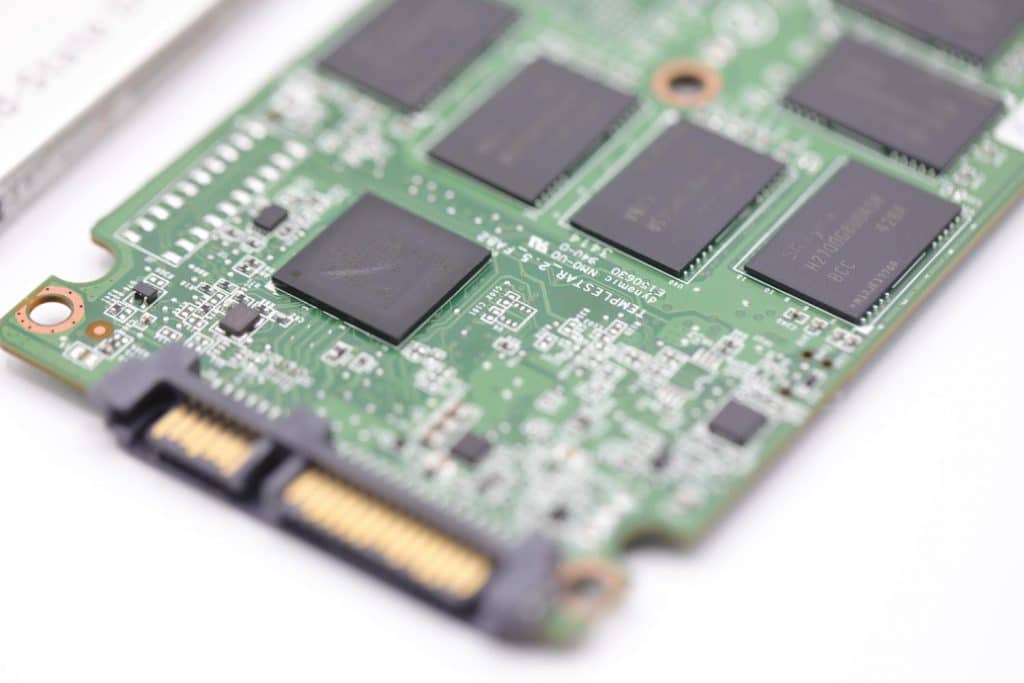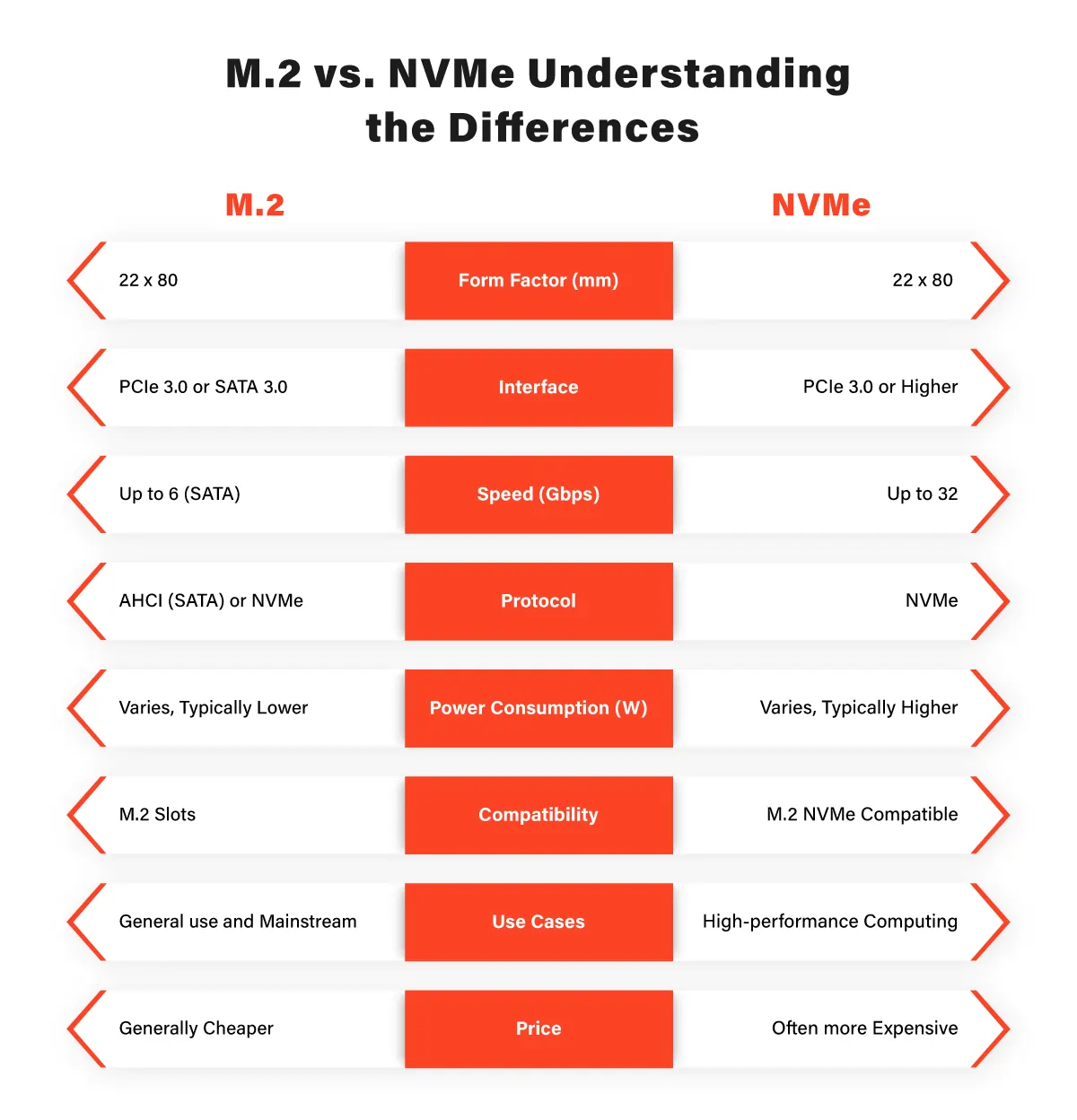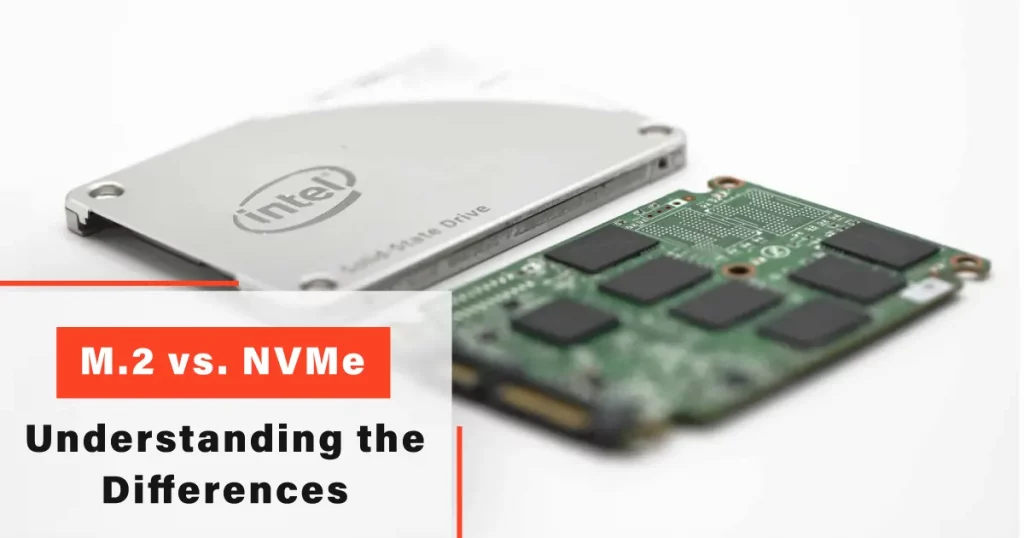In the world of storage drives, two terms that often come up are M.2 and NVMe. If you are building or upgrading your computer, understanding the differences between these two technologies can significantly impact your system’s performance and overall experience. In this blog post, we will delve into the world of M.2 and NVMe, exploring their definitions, benefits, and how they compare to each other in terms of form factors, compatibility, and performance.
What is M.2?
M.2 is not a performance indicator, as some might mistakenly think; it is, in fact, a form factor. It refers to a small, slim, and highly versatile solid-state drive form factor that has gained immense popularity in recent years due to its compact size and impressive performance capabilities. M.2 SSDs are designed to be directly mounted onto the motherboard, allowing for a clutter-free and efficient setup. They come in various lengths and widths, denoted by numbers such as 2242, 2260, 2280, and 22110, indicating their dimensions in millimeters.

Benefits of M.2
One of the key benefits of M.2 SSDs is their enhanced speed over traditional SATA SSDs. While SATA drives are well-known for their reliability and performance, M.2 SSDs, especially those equipped with NVMe technology, take data transfer speeds to a whole new level. This results in quicker boot times, faster application launches, and seamless multitasking.
Moreover, M.2 form factors free up valuable space in your PC case, allowing for better airflow and contributing to overall system cooling. Their compact design is particularly advantageous for smaller form factor PCs, such as mini-ITX builds, where space optimization is crucial.
Understanding NVMe
NVMe stands for “Non-Volatile Memory Express,” and it is not a form factor like M.2 but rather a protocol or interface that governs the communication between storage devices and the motherboard. NVMe is designed explicitly for flash memory, which is the primary storage medium used in modern SSDs. The NVMe protocol is built to leverage the capabilities of PCIe (Peripheral Component Interconnect Express), a high-speed interface commonly used for graphics cards and other peripherals, to achieve exceptional read and write speeds.
Benefits of NVMe
The most significant advantage of NVMe drives is their blistering fast transfer speeds. Unlike the traditional SATA interface, which has a theoretical maximum speed of around 600 MB/s, NVMe can reach sequential read and write speeds in the range of multiple gigabytes per second. This exponential increase in speed translates to significantly reduced loading times for applications and games, making NVMe SSDs a preferred choice for gamers and content creators seeking top-notch performance.

M.2 vs. NVMe
Now that we have clarified the distinctions between M.2 and NVMe, let’s compare the two:
Form Factors and Compatibility
M.2 is a form factor, while NVMe is a protocol. This means that an M.2 SSD can use either the SATA or NVMe protocol. As a result, M.2 SSDs can be found in both SATA and NVMe variants. On the other hand, traditional SATA SSDs, which come in the 2.5-inch form factor, are not compatible with the M.2 slot.
Speed and Performance
When comparing M.2 SATA SSDs to NVMe SSDs, the latter outperforms the former by a significant margin in terms of read and write speeds. While M.2 SATA SSDs still offer excellent performance over traditional hard drives, NVMe drives take data transfer speeds to unparalleled heights.
Compatibility with Motherboards
Most modern motherboards come with M.2 slots that support both SATA and NVMe SSDs.
However, it is essential to check the motherboard’s specifications to ensure compatibility with NVMe if you plan to utilize its full potential.
In conclusion, M.2 and NVMe are both cutting-edge technologies that have revolutionized the storage drive landscape. M.2’s compact form factor, along with the option to choose between SATA and NVMe variants, makes it an attractive choice for various PC builds. Meanwhile, NVMe’s lightning-fast speeds have propelled it to the forefront of storage technology, delivering unparalleled performance for enthusiasts and professionals alike.
When considering which type of SSD to opt for, it is essential to assess your specific needs and budget. If lightning-fast transfer speeds and optimal performance are paramount, NVMe is undoubtedly the way to go. However, if you seek a balance between speed and affordability, M.2 SATA SSDs still provide a significant upgrade over traditional SATA drives.
Frequently Asked Questions
What is the difference between M.2 and NVMe?
M.2 and NVMe are not directly comparable as they refer to different aspects of SSD technology. M.2 is a form factor, representing the physical size and shape of the SSD, while NVMe is a protocol that determines how data is transferred between the storage device and the motherboard. M.2 SSDs can come in both SATA and NVMe variants, with NVMe offering significantly faster read and write speeds compared to traditional SATA drives.
Can all M.2 SSDs be classified as NVMe drives?
No, not all M.2 SSDs are NVMe drives. M.2 is a form factor that accommodates various types of SSDs. M.2 SSDs can use either the SATA or NVMe protocol. M.2 SATA SSDs operate at SATA speeds, while NVMe SSDs use the NVMe protocol and deliver much higher data transfer rates. Therefore, it is essential to check the specifications of the M.2 SSD to determine if it is an NVMe or SATA variant.
Are NVMe SSDs compatible with all motherboards that have M.2 slots?
Most modern motherboards that come with M.2 slots are compatible with both SATA and NVMe SSDs. However, it’s crucial to verify the motherboard’s specifications to ensure NVMe compatibility. Some older motherboards may have M.2 slots that support only SATA-based M.2 SSDs and do not offer NVMe support. Upgrading to a motherboard with proper NVMe support is necessary to take advantage of the full performance benefits of NVMe SSDs.
Which is faster: M.2 SATA or NVMe SSD?
NVMe SSDs are faster than M.2 SATA SSDs. The SATA interface has theoretical maximum speeds of around 600 MB/s, limiting M.2 SATA SSDs to similar performance levels. In contrast, NVMe SSDs can achieve sequential read and write speeds in the range of multiple gigabytes per second. This significant increase in speed makes NVMe SSDs ideal for demanding applications, gaming, and content creation tasks.
Are there any benefits to using M.2 SATA SSDs over traditional SATA SSDs?
Yes, there are benefits to using M.2 SATA SSDs over traditional SATA SSDs. M.2 SATA SSDs are more compact and do not require power or data cables, making them easier to install and contributing to a cleaner and more organized PC build. They are also a great choice for laptops and small form factor PCs due to their space-saving design. While not as fast as NVMe SSDs, M.2 SATA SSDs still offer a significant performance improvement over traditional hard drives and can be an affordable upgrade option for users seeking better storage speeds.
